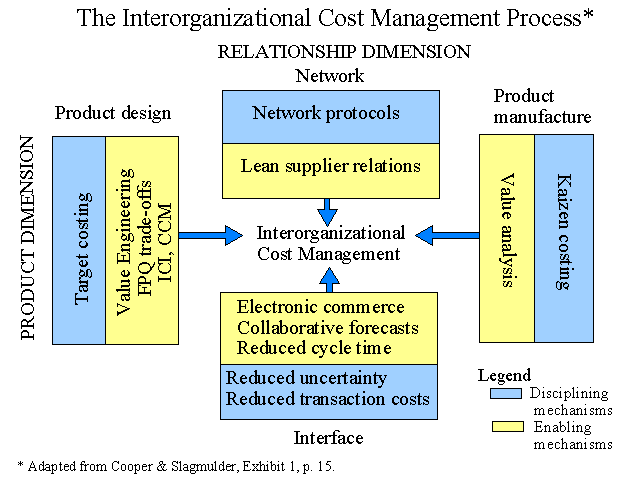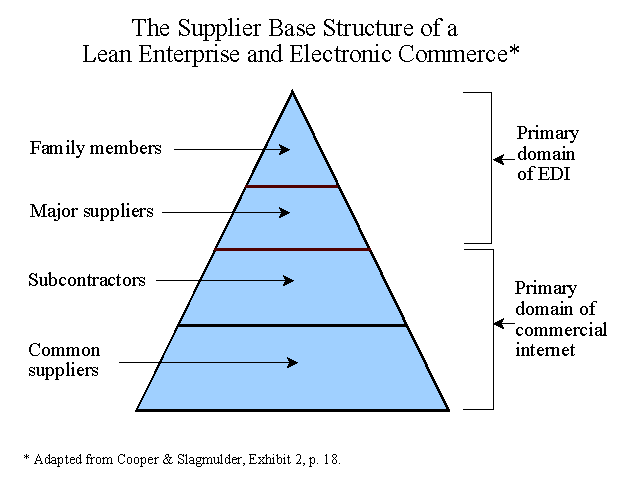
Summary by Jodi Corcoran
Master of Accountancy Program
University of South Florida, Fall 2004
Cost Management Main Page | JIT Main Page
This is the first article in a two part series. Cooper and Slagmulder provide an introduction to interorganizational cost management and a discussion of the first dimension of the interorganizational cost management process, the network and the interface.
Interorganizational Cost Management (ICM)
Definition: Method to increase profitability by managing and reducing costs across two dimensions through the coordination and cooperation amongst organizations in a supplier network.
Objective: Identify ways to minimize costs and thus increase profits through teamwork.
Cooperation (conducive) vs. Isolation (not conducive)
Cooperation - Decrease overall cost, increase overall profits. Lean supplier networks with the following characteristics: interdependence, trust, and extensive information sharing.
Isolation - Decrease individual cost, not the team mentality. Adversarial relationships, “Every firm for itself” = Western Firms (e.g., American firms).
Profit Sharing Incentive
Sharing in profits is an incentive for the weak and the powerful firms to cooperate in a supply network. Equitable sharing maximizes the motivation to improve.
ICM motivates independent, external buyers and suppliers and internal divisions and subsidiaries acting as suppliers. ICM remedies the internal problem of the potential lack of freedom to decide with whom to conduct business by providing transfer prices to pressure the division or subsidiary to minimize cost at a rate approximately equal to the rate of external suppliers.
The Interorganizational Cost Management Process
The ICM process can lower cost across the relationship dimension as well as the product dimension. The relationship dimension includes the network and the interface. This article refers to cost reduction across the relationship dimension (i.e., the vertical dimension in the graphic illustration below). See Interorganizational Costing, Part 2 for a discussion of reducing costs across the product dimension (i.e., the horizontal dimension in the graphic).

The Network
Lean Supplier Relations:
Lean enterprises practicing lean supply focus on the single piece flow concept where the buyer uses the supplier as a just-in-time factory.
To undertake ICM, firms must establish the right kind of lean buyer-supplier relationships. Four characteristics of such relationships are as follows:
reduced supplier base,
high buyer reliance on supplier product design innovation,
stable, highly cooperative, mutually beneficial relationships, and
blurred organizational boundaries.
Whole > Sum(Parts + Parts). All firms involved operate as one unit to reduce cost and meet customer demands. Two advantages of networks in comparison to vertically integrated mass producers are flexibility and responsiveness.
Network Protocols:
Network protocols are common values and shared behaviors between the network as a whole designed to the reduce negative effects of too much competition and to promote cooperation across boundaries. Network protocols help to ensure maximum benefit is derived from the network. How network protocols are enforced differs across the different types of networks.
Three Types of Networks:
1. Kingdom - One firm has the most power (most often, the firm selling the product to the customer). Network operates to support the dominant firm. Protocols developed top down.
2. Barony - Several firms are in positions of power. Power of the barons is reduced in comparison to the single firm of a kingdom. Barons dominate the negotiation of protocols.
3. Republic - No firm is more powerful than another. Mutually agreed upon protocols.
ICM is effective for kingdoms and baronies where the more powerful firms can pass down protocols to the lowest firm in the supply chain. ICM is not effective for republics due to their short term relations and firm production capability specialization.
The Interface
Buyer assumes a kanban (pull) approach seeking to maintain inventory at a minimum and allow for supplier level just in time production.
Reduced Uncertainty and Reduced Transaction Costs:
The buyer-seller interface is all the interactions between firms in the supplier network. Two primary ways to increase the efficiency of the buyer-supplier interface are to reduce uncertainty and transaction processing costs.
Four ways to reduce transaction processing costs are as follows:
eliminate duplicate activities,
simplify common processes,
standardize high volume, routine activities and processes, and
automate repetitive, high volume activities.
Inventory is a buffer against uncertainty. Eliminating uncertainty will help to eliminate excess inventory. Two ways to reduce uncertainty include increasing the amount of information shared and decreasing transaction processing time.
Benefits of an efficient buyer-seller interface are reduced inventory and improved customer-supplier relations.
Three ways in which to improve the buyer-seller interface are through jointly initiated, buyer initiated, and supplier initiated improvements.
Jointly Initiated Improvements
Two important improvements are automating information transfers through electronic commerce and standardizing the order delivery process by collaborating forecasts and reducing cycle time.
Electronic Commerce:
With today’s technology, companies can conduct business electronically. With electronic data interchange (EDI), interface efficiency can be improved by reducing transaction processing and increasing information flow.
Electronic commerce reduces transaction processing costs by decreasing paper documentation, eliminating data reentry (reducing clerical errors), and decreasing cycle time.
Three applications of e-commerce are electronic purchasing of standard items, communicating orders to suppliers (e-mailing bidding), and automated physical transfers by barcode.
The supplier base structure of a lean enterprise and electronic commerce shows four levels of the supplier base: family members, major suppliers, subcontractors, and common suppliers. There is a cost-benefit tradeoff between using electronic data interchange and the commercial internet. The supplier network for a lean enterprise includes a core firm, first-tier suppliers, and second-tier suppliers. Core firms have the means to purchase the technology, whereas, smaller firms despite having more transactions can’t afford to implement sophisticated information technology.

Reduced Cycle Time and Collaborate Forecasts:
The steps to improve the order-delivery process are standardization, improved integration, and collaborative forecasts. Note: The order-delivery process should be standardized prior to automation.
Advantages to developing common forecasts
Early identification of shortages,
Excess capacity avoided,
Faster and more efficient forecasts.
Buyer and Supplier Initiated Improvements:
Buyer initiated improvements that decrease uncertainty:
Manage demand
Provide adequate order lead time
Reduce special orders
Share forecasts
Buyer initiated improvements that decrease transaction processing time:
Extended purchase contracts
Pay on receipt
Accurate communications
Supplier initiated improvements that decrease uncertainty:
Reduced delivery cycle time
Deliver on time
Reduce production cycle time
Share performance metrics
Share forecasts
Buyer access to order status
Supplier initiated improvements that decrease transaction processing time:
Inventory control to suppliers,
Accurate communications
This concludes the summary of part one, the relationship dimension. In the second part of this article, the authors address the second dimension of the interorganizational process, the product dimension.
Cooper, R. and R. Slagmulder. 2003. Interorganizational costing, Part 2. Cost Management (November/December): 12-24. (Summary).
______________________________________________
Related summaries:
Clinton, B. D. and S. C. Del Vecchio. 2002. Cosourcing in manufacturing. Journal of Cost Management (September/October): 5-12. (Summary).
Clinton, B. D. and S. C. Del Vecchio. 2002. Cosourcing in manufacturing - Just in time. Journal of Cost Management (November/December): 30-37. (Summary).
Dummer, W., M. Masters and D. Swenson. 2015. Delivering customer value through value analysis. Cost Management (March/April): 17-24. (Summary).
Martin, J. R. Not dated. Lean concepts and terms. Management And Accounting Web. Lean Concepts and Terms Summary
Martin, J. R. Not dated. Profit Beyond Measure graphics and notes. Management And Accounting Web. Johnson Broms Graphics Notes
Martin, J. R. Not dated. Supply chain arrangements. Management And Accounting Web. Supplier Arrangements Summary
Martin, J. R. Not dated. What is lean accounting? Management And Accounting Web. Lean Accounting
Porter, M. E. 2001. Strategy and the internet. Harvard Business Review (March): 63-78. (Summary).